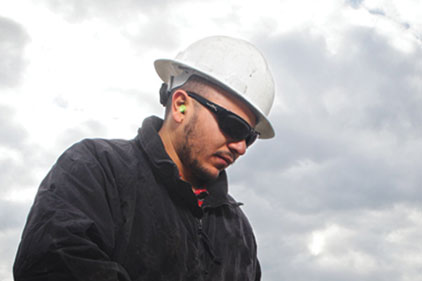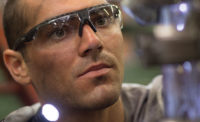When carpenters were surveyed by NIOSH1 about what would encourage them to use safety eyewear regularly, some of their responses were, well, eye-opening.
The top answer?
The carpenters said they would use their safety eye equipment if it was well-fitting, stylish and comfortable. They also wanted a choice of eyewear (Answer #2), both dark and clear lenses (Answer #3) and holders and straps that would make the safety eyewear accessible (Answer #4).
We’ll explore these preferences in detail, but first: a sobering reminder of why it’s so important for at-risk employees to wear eye protection.
By the numbers
Job-related eye injuries blind thousands of people each year and cost U.S. employers more than $300 million in lost production time, medical expenses and worker compensation.2 Eye doctors estimate that 90% of occupational eye injuries could be lessened in severity or even prevented – had eye protection or the right kind of eye protection been worn.3
Different industries, different hazards
The variety of dangers to which workers’ eyes are exposed depends upon the work environment, the tasks workers are required to do and the materials they must work with in order to accomplish those tasks.
Different industries and job types produce different hazards. Construction workers have one of the highest eye injury rates overall. They are often injured by the rebounding of nails or by metal slivers caused by hammering. Carpenters’ most common source of eye injury: particles of dust, metal, wood, slag, drywall or cement.5 Welders can suffer eye damage from exposure to arcs and flashes (intense UV radiation).
As with any form of PPE, determining your employees’ eye protection needs starts with a hazard assessment. Your evaluation should encompass the entire work environment, since factors like dust and wind can send particles into eyes, and hazards generated by nearby operations can injure a worker who is not, himself, performing a hazardous task.
From flying objects to radiation
OSHA identifies five categories of eye-related hazards and recommends appropriate PPE for them:
Impact hazard: This type of injury involves flying objects like large chips, particles, fragments, sand and dirt and can occur during chipping, grinding, machining, masonry work, wood working, sawing, drilling, riveting and sanding activities.
Eye protection: Safety spectacles, goggles or face shields.
| Safety spectacles shield the wearer’s eyes from flying fragments, objects, large chips and particles. If flying objects are a potential danger in the workplace, workers are required to use safety spectacles with side shields. |
| Goggles form a protective seal around the eyes, thus preventing objects from entering under or around the eyewear. |
| Face shields offer benefits, but when worn alone they do not protect the employee from impact hazards. When used in combination with safety spectacles or goggles, they can help protect against flying fragments, objects, large chips, and particles. |
Heat hazard: Furnace operations, pouring, casting, hot dripping and welding activities can result in eye injuries.
Eye protection: This type of hazard can also be countered with a variety of eye protection.
- Safety spectacles used in combination with a heat-reflective face shield can adequately protect the eyes and face from high temperature exposure.
- Safety goggles can also be used as primary protection to shield the eyes (but not the rest of the face) from heat hazards. Goggles are especially useful when working with or around molten metals that may splash.
Chemical hazard: Acid and chemical handling, degreasing, plating and working with blood can expose the eyes to splashes, fumes, vapors and irritating mists.
Eye protection: Safety goggles form a protective seal that prevent liquids from reaching the eyes, eye sockets and the facial area immediately surrounding the eyes.
Dust hazard: Harmful dust can get into the eyes during woodworking, buffing and in worksites with generally dusty conditions.
Eye protection: Dust hazards are also best met with safety goggles or close-fitting, sealed spectacles.
Optical radiation hazard: Eyes can be damaged by radiant energy, glare and intense light emitted during welding, torch-cutting, brazing, soldering and laser work.
Eye protection: Filter lenses with the correct filter shade number will protect against radiation hazards. When selecting this type of PPE, you must consider the type and degree of radiant energy in the workplace.
The standards
Whatever form of eye protection you choose, it should comply with with ANSI Z87.1 OSHA accepts the three latest standards: 1989, 2003 and 20106. Additionally, OSHA requires employers to provide PPE training so that workers know what to use, when to use it, how to wear it, how to take care of it and what its limitations are.4
Comfort and compliance
Although the NIOSH survey mentioned at the beginning of the article involved carpenters, the information garnered may provide insight into the attitudes of other workers as well. The inclusion of style as a high priority shouldn’t come as a surprise to employers. When it comes to this very personal form of personal protective equipment, people expect to be able to find styles that affirm or express their individuality. Function is still important when it comes to eyewear but workers are no longer willing to base their selection on that factor alone.
The safety eyewear industry has responded to this demand trend by producing frames in a multitude of colors, finishes and shapes. Many frames are prescription-ready. Lenses come in a range of hues: bronze, sky blue and smoke grey, among others, or in a photochromic version which can be used in bright sunlight or relative darkness. There are also hybrid spectacles that, for instance, include removable, soft foam seals to offer the protection of goggles but the low-profile of glasses.
Fit and comfort are closely related. PPE that doesn’t fit well cannot be comfortable – nor can it provide the protection that it’s meant to. A good fit starts with choosing the correct size, if different sizes of PPE are available. Fit is especially important where dust and chemical splashes are hazards; the device should fit the face snugly. Adjustable features can further refine fit.
Features like non-slip rubberized temples and nose pieces and adjustable rubber nose bridges with wire cores lend themselves to both fit and comfort in protective eyewear.
Put a policy in place
Once you’ve determined the appropriate type of eye protection that’s needed, allowing workers some choice in their eye protection devices goes a long way toward ensuring compliance — but not far enough.
NIOSH recommends that you develop and implement an eye safety policy1 for your workplace, one that specifies:
- When safety eye protection must be worn
- How the policy is enforced
- How and from where workers get their safety glasses
- How they get replacements
- What a worker should do if the eye protection that is usually at a workstation is missing
References
1 NIOSH Eye Safety Toolbox Talk: http://www.cdc.gov/niosh/topics/eye/toolbox-eye.html
2 OSHA: Eye and Face Protection www.osha.gov/SLTC/eyefaceprotection/index.html
3 American Optometric Association website: www.aoa.org/x4736.xml
4 OSHA “Eye and Face Protection” www.osha.gov/SLTC/.../ef.ppt
5 www.osha.gov/pls/oshaweb/owadisp.show_document?p_table=STANDARDS&p_id=10120


